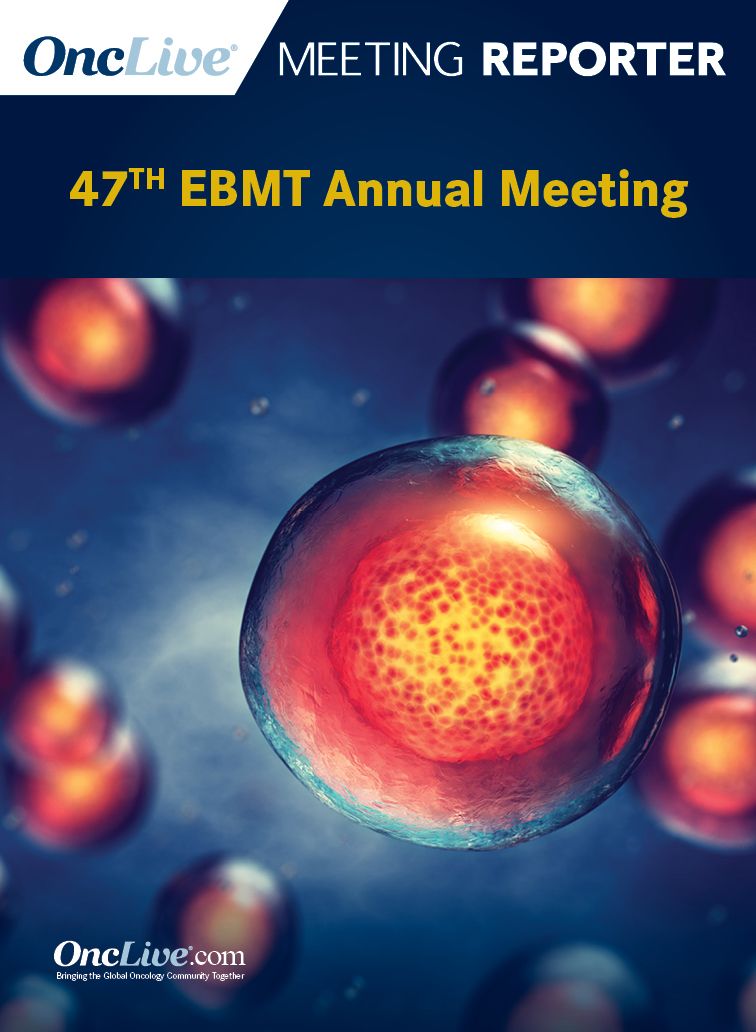Publication
Article
Supplements and Featured Publications
Omidubicel Showcases Promising Outcomes in High-Risk Hematologic Cancers Following Myeloablation
Author(s):
Omidubicel was associated with a significantly improved median time to neutrophil engraftment compared with standard umbilical cord blood transplantation in patients with high-risk hematologic malignancies.
Guillermo F. Sanz, MD, PhD

Omidubicel was associated with a significantly improved median time to neutrophil engraftment compared with standard umbilical cord blood (UCB) transplantation in patients with high-risk hematologic malignancies, according to results of a phase 3 trial that were presented during the Virtual 47th Annual Meeting of the EBMT.1
Findings showed that, in the intent-to-treat (ITT) population (n = 125), the median time to neutrophil engraftment was 12.0 days (95% CI, 10.0-15.0) compared with 22.0 days (95% CI, 19.0-25.0) in the control UCB arm (P <.001). In the as-treated group (n = 108), these median times were 10.0 days (95% CI, 8-13) and 20.5 days (95% CI, 18-24), respectively (P <.001).
Additionally, omidubicel was associated with a 41% reduction in the risk of death compared with standard UCB (HR, 0.59; 95% CI, 0.29-1.12; P = .16); however, the study was not powered to look at overall survival, explained lead study author Guillermo F. Sanz, MD, PhD.
“This global phase 3 randomized study demonstrates that transplantation with omidubicel results in faster hematopoietic recovery, fewer infections, and fewer days in hospital,” said Sanz, of the Department of Hematology at Hospital Universitari i Politècnic la Fe, in Valencia, Spain, in a virtual presentation during the meeting. “These data suggest that omidubicel should be considered as the new standard of care for patients eligible for umbilical cord blood transplantation.”
Omidubicel is a cellular product that consists of 2 cryopreserved fractions derived from a single entire cord blood unit and is thawed at transplant centers immediately prior to infusion. The cells are obtained after CD133+ selection ex vivo expanded for 21 days in the presence of nicotinamide. The agent also comprises non-cultured CD133-negative cells that include T cells, Sanz added.
Nicotinamide has been found to increase stem and progenitor cells, to inhibit differentiation and increase migration, bone marrow homing, and engraftment efficiency, while preserving cellular functionality and phenotype.
A prior phase 1/2 trial explored omidubicel in 36 patients with high-risk hematologic malignancies who were undergoing myeloablative conditioning; 78% of patients had an intermediate/high disease-risk index. Treatment was given to patients at a median dose of 6.3 x 106/kg.
Results showed that omidubicel led to very fast hematopoietic engraftment in this patient population. The median time to neutrophil engraftment was 11.5 days, the median time to platelet engraftment was 34 days, and the median days that patients were alive and out of the hospital prior to day +100 was 73 days (P <.001 for all as compared with 146 similar patients reported to the Center for International Blood and Marrow Transplant Research).2 Moreover, the treatment led to durable long-term hematopoietic engraftment that lasted for more than 10 years.
In the phase 3 study, patients with high-risk acute myeloid leukemia (n = 60), acute lymphoblastic leukemia (n = 41), myelodysplastic syndromes (n = 9), chronic myeloid leukemia (n = 6), and lymphoma (n = 5), and rare leukemia (n = 4) were randomized 1:1 to receive omidubicel or standard UCB. To be eligible for enrollment, patients had to be between the ages of 12 years and 65 years, be candidates for allogeneic stem cell transplantation, and not have a matched donor. Patients were from 33 centers in the United States, Europe, South America, and Asia.
Cord blood units were selected prior to randomization, which was stratified by treatment center, disease risk index, age, and intent to perform single vs double cord transplant in the control arm.
The primary end point of the trial was time to neutrophil engraftment; secondary end points were time to platelet engraftment, infections by 100 days posttransplant, and hospitalizations, which was defined as the days alive and out of the hospital in the first 100 days posttransplant.
The intent-to-treat population (n = 125) included 62 patients on omidubicel and 63 on standard transplant. In the as-treated population, patients received transplant with omidubicel (n = 52) or control (n = 56) per protocol.
Patient characteristics were well balanced between the 2 arms. More than half (57.5%) of patients were male and the median age was 41.5 years. Most patients were White (58%), and 13% of patients were Latino. Twenty-four percent of patients had low-risk disease, while 42% had moderate-risk disease, and 34.5% had high/very high-risk disease. The myeloablative conditioning regimens were 2 total body irradiation-based regimens with thiotepa, fludarabine, and cyclophosphamide (48.5%) or 1 with thiotepa, busulfan, and fludarabine (44%).
In the first cord blood unit, the HLA match was 4/6 in 73.5% of patients, 5/6 in 24.5%, and 6/6 in 2% of patients. In patients who received a second cord blood unit, which applied to the control arm only, the 4/6, 5/6, and 6/6 HLA matches occurred in 74%, 24%, and 2%, respectively. Additionally, 32.5% and 67.5% of patients had single and double intended UCB transplant, respectively.
Data also showed that the median CD34-positive cell expansion was 130-fold (range, 32-233). In the ITT population, the cumulative day 42 incidence of platelet engraftment was 55% with omidubicel vs 35% with the control arm (95% CI, 0.03-0.35; P = .028). In the as-treated population, the median time to platelet engraftment was 37 days (95% CI, 33-42) with omidubicel and 50 days (95% CI, 42-58) for the control arm (P = .023).
Grade 2/3 bacterial or invasive fungal infection by 100 days in the ITT population was lower with omidubicel at 37% compared with 57% in the control arm (P = .027). This was similar with viral infection rates at 10% vs 26% with omidubicel and control, respectively (P = .029).
Omidubicel recipients had a median 60.5 days alive and out of the hospital in the first 100 days posttransplant compared with a median 48.0 days for patients on the control arm (P = .005).
Sanz noted no differences in grade 2/3 acute graft-vs-host disease (GVHD) with the omidubicel and control arms (P = .18) nor with grade 3/4 acute GVHD (P = .33); this trend cascaded into chronic GVHD at 1 year (P = .57).
There was a trend toward lower non-relapse mortality (P = .09) with omidubicel compared with the control arm; the risk for relapse was similar in both arms (P = .32).
Moreover, the disease-free survival rate was higher with omidubicel vs that of the control arm (P = .68), but Sanz noted that, similar to the OS report, the trial was not powered to assess this end point.
References
- Sanz GF, Stiff PJ, Cutler CS, et al. Results of a phase III randomized, multicenter study comparing omidubicel with standard umbilical cord blood transplantation (UCBT) in patients with high-risk hematologic malignancies following myeloablation. Presented at: 47th Annual Meeting of the EBMT; March 14-17, 2021; Virtual. Abstract GS2-7.
- Horwitz ME, Wease S, Blackwell B, et al. Phase I/II study of stem-cell transplantation using a single cord blood unit expanded ex vivo with nicotinamide. J Clin Oncol. 2019;37(5):367-374. doi:10.1200/JCO.18.00053








%20u.jpg?fit=crop&auto=format)

